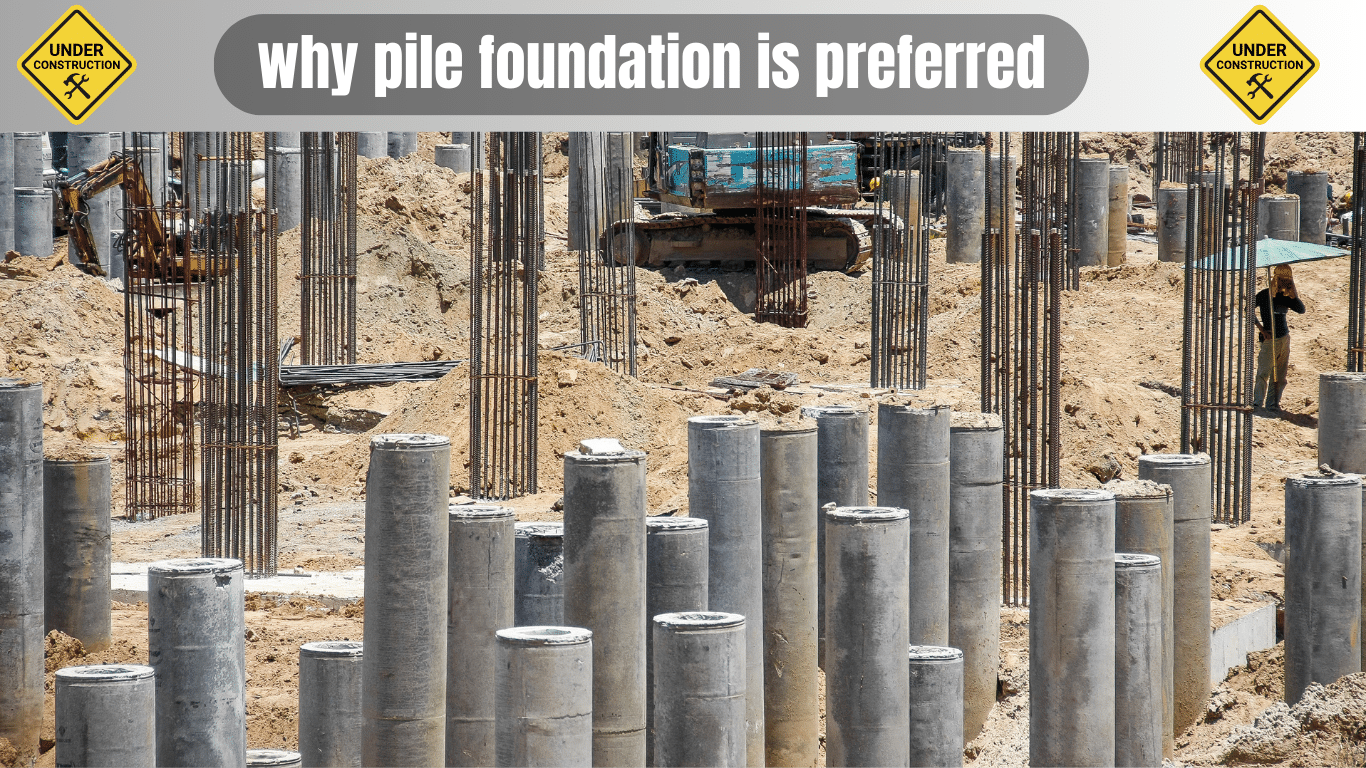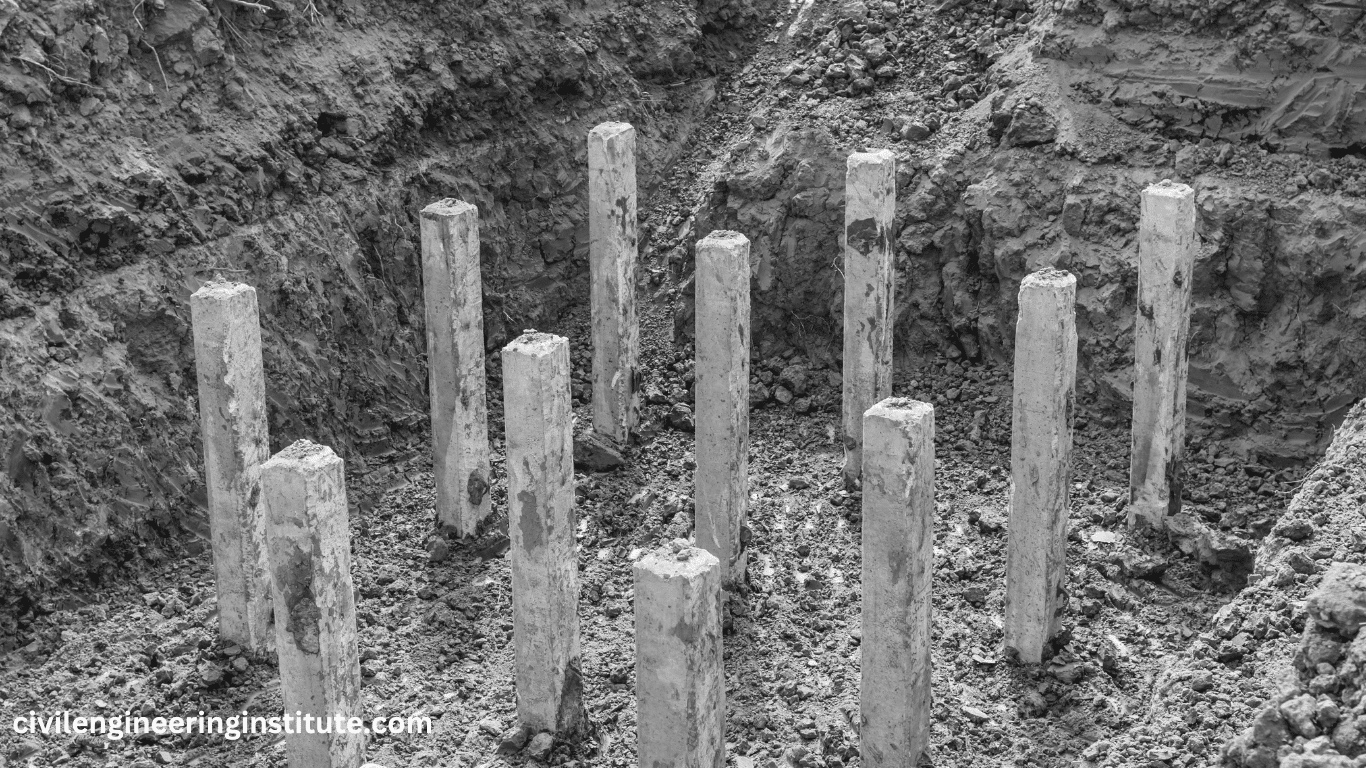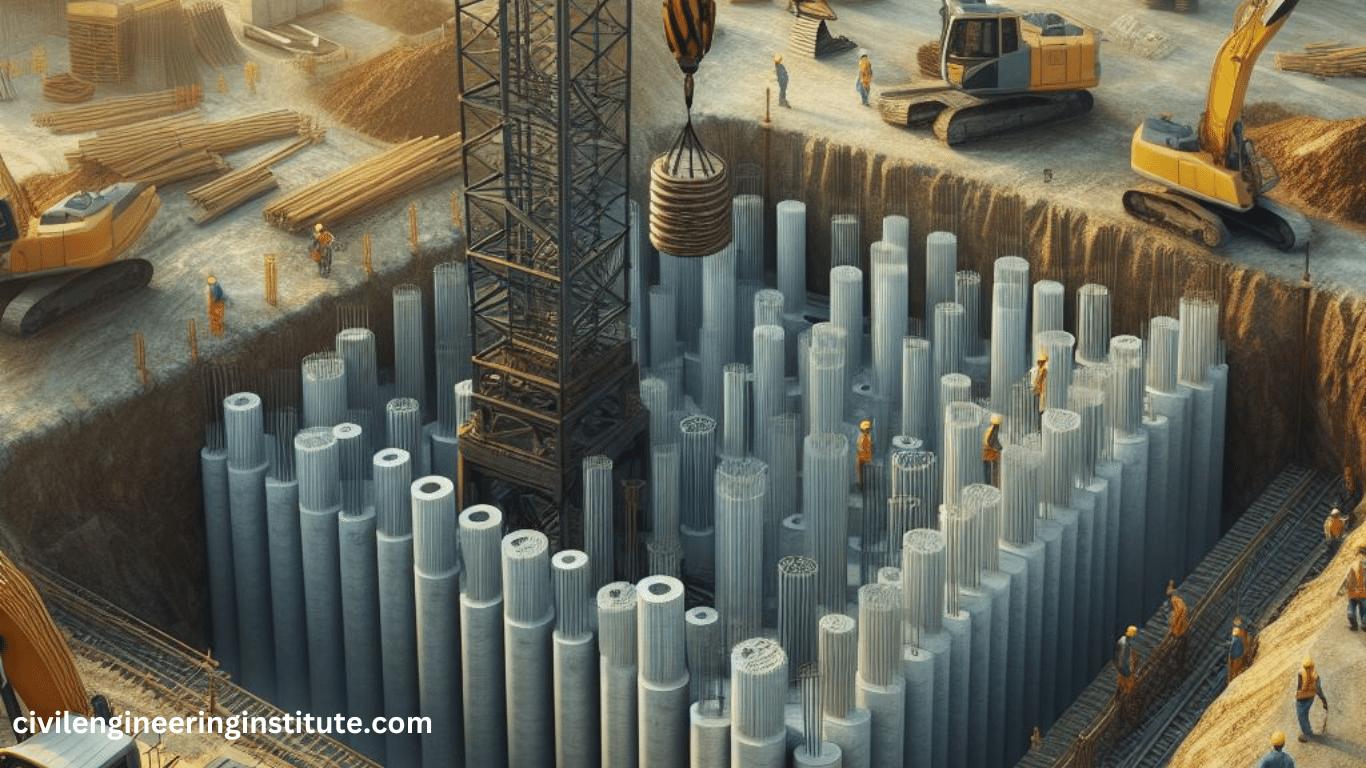why pile foundation is preferred in construction because they provide stability, especially in tricky soil conditions. When the ground is weak or prone to shifting, regular foundations might not hold up well. Pile foundations, on the other hand, go deep into the ground, reaching stable layers that can support the weight of the building. They’re like sturdy pillars holding everything up.
Plus, they can handle heavy loads, making them perfect for tall buildings or structures like bridges. Another great thing about pile foundations is that they’re versatile – they can be used in all sorts of soil types, even underwater! And because they disturb the environment less during construction, they’re better for nature. Overall, pile foundations are preferred because they’re strong, reliable, and adaptable to different construction needs.
Why Pile Foundation is Preferred: Ensuring Stability in Construction
In the world of construction, stability is key. Whether it’s a towering skyscraper or a humble home, the foundation upon which a structure is built determines its strength and longevity. One method that ensures stability, particularly in challenging soil conditions, is the use of pile foundations. In this article, we will delve into why pile foundations are preferred in construction projects, exploring their benefits and applications in a simple and easy-to-understand manner.
What are pile foundations?
Before we dive into why pile foundations are preferred, let’s understand what they are. Pile foundations are structural elements that are driven, drilled, or vibrated into the ground to provide support for buildings and other structures. These cylindrical or square-shaped columns are typically made of concrete, steel, or wood and transfer the load of the structure to deeper, more stable layers of soil or rock beneath the ground surface.
Why Pile Foundation is preferred?
- Stability in Challenging Soil Conditions
- Load-Bearing Capacity
- Versatility
- Minimal Environmental Impact
- Cost-Effectiveness
Stability in Challenging Soil Conditions
One of the primary reasons pile foundations are preferred is their ability to provide stability in challenging soil conditions. In areas where the soil is weak or prone to settling, traditional shallow foundations may not suffice. Pile foundations penetrate through the unstable soil layers and transfer the structural load to more competent strata below, ensuring the stability of the structure above.
Load-Bearing Capacity
Pile foundations offer excellent load-bearing capacity, making them suitable for supporting heavy structures such as high-rise buildings, bridges, and industrial facilities. By distributing the load over a greater area of soil or rock, pile foundations can withstand significant vertical and lateral forces without compromising the integrity of the structure.
Versatility
Another reason for the preference of pile foundations is their versatility. They can be installed in various soil types, including cohesive soils, granular soils, and even underwater conditions. This flexibility makes pile foundations suitable for a wide range of construction projects, from urban skyscrapers to offshore platforms.
Minimal Environmental Impact
Pile foundations have minimal environmental impact compared to other foundation types. Unlike shallow foundations, which may require extensive excavation and soil removal, pile foundations involve minimal disturbance to the surrounding environment. Additionally, pile installation techniques such as driven piles or helical piles produce minimal noise and vibration, reducing disruption to nearby structures and communities.
Cost-Effectiveness
While pile foundations may require a higher initial investment compared to shallow foundations, they often prove to be more cost-effective in the long run. By ensuring the stability and longevity of the structure, pile foundations reduce the need for costly repairs and maintenance over time. Furthermore, the ability to construct pile foundations in challenging soil conditions can eliminate the need for expensive soil improvement techniques, saving both time and money during the construction process.
Applications of Pile Foundations
Now that we understand why pile foundations are preferred, let’s explore some common applications:
- High-Rise Buildings
- Bridges and Infrastructure
- Offshore Structures
- Industrial Facilities
High-Rise Buildings: Pile foundations are commonly used in the construction of high-rise buildings, providing the necessary support to withstand the vertical and lateral loads exerted by tall structures.
Bridges and Infrastructure: Pile foundations play a crucial role in supporting bridges, viaducts, and other infrastructure projects, ensuring stability and longevity in diverse soil conditions.
Offshore Structures: In offshore construction, where soil conditions are particularly challenging, pile foundations are essential for supporting platforms, oil rigs, and wind turbines in deep waters.
Industrial Facilities: Industrial structures such as power plants, refineries, and storage tanks often require pile foundations to support heavy equipment and withstand dynamic loads.
Nowadays, people are searching for many different questions and answers regarding pile foundation, so here I am trying to solve some of their queries.
Why do we choose pile foundation?
Pile foundations are chosen for their ability to provide stability and support to buildings and structures, especially in challenging soil conditions. When the ground is weak or prone to settling, regular shallow foundations might not be enough to keep everything steady. Pile foundations go deep into the ground, reaching stable layers that can hold up the weight of the structure above. This ensures that the building stays safe and secure for years to come.
What are the advantages of pile foundations?
There are several advantages to using pile foundations. Firstly, they offer excellent load-bearing capacity, making them suitable for supporting heavy structures like tall buildings and bridges. Secondly, pile foundations can be installed in various soil types, including cohesive soils and granular soils, as well as underwater conditions, making them versatile. Additionally, pile foundations have minimal environmental impact compared to other foundation types, as they involve less disturbance to the surrounding environment during construction.
In which situation is a pile foundation recommended?
Pile foundations are recommended in situations where the soil is weak or prone to settling, or where the structure being built is particularly heavy or tall. They are also suitable for use in areas with challenging soil conditions, such as coastal regions or areas with high groundwater levels. Additionally, pile foundations are often used in urban environments where space is limited, as they require less surface area compared to shallow foundations.
Why is a pile foundation better than a raft foundation?
While both pile foundations and raft foundations are used to support buildings and structures, pile foundations are often preferred in situations where the soil is weak or unstable. Unlike raft foundations, which spread the load of the structure over a large area, pile foundations transfer the load to deeper, more stable layers of soil or rock, providing greater stability and support. Additionally, pile foundations can be more cost-effective in the long run, as they reduce the need for expensive soil improvement techniques.
What is the purpose of piles?
The purpose of piles is to provide support and stability to buildings and structures by transferring the load of the structure to deeper, more stable layers of soil or rock. Piles are typically made of concrete, steel, or wood and are driven, drilled, or vibrated into the ground to reach these stable layers. By distributing the load over a greater area of soil or rock, piles help to prevent settlement and ensure the integrity of the structure above.
Is pile foundation cheaper?
The cost of pile foundation depends on various factors, including the type of piles used, the depth of the piles, and the soil conditions at the construction site. In some cases, pile foundations may be more expensive than shallow foundations upfront due to the cost of materials and installation. However, pile foundations can be more cost-effective in the long run, as they reduce the need for expensive soil improvement techniques and can prevent costly repairs and maintenance due to settlement or instability.
Is a pile foundation good or bad?
Pile foundations are generally considered to be a good choice for supporting buildings and structures, especially in challenging soil conditions. They offer excellent load-bearing capacity, stability, and versatility, making them suitable for a wide range of construction projects. However, like any construction method, the success of a pile foundation depends on factors such as proper design, installation, and maintenance. When installed correctly, pile foundations can provide reliable support for buildings and structures for many years.
Which is better, piling or footing?
The choice between piling and footing depends on various factors, including the soil conditions at the construction site, the size and weight of the structure being built, and budget considerations. Piling is often preferred in situations where the soil is weak or prone to settling, or where the structure being built is particularly heavy or tall. Footing, on the other hand, spreads the load of the structure over a larger area and is suitable for use in more stable soil conditions. Ultimately, the best choice will depend on the specific requirements of the project.
How strong is the pile foundation?
Pile foundations are designed to be very strong and capable of supporting heavy loads. The strength of a pile foundation depends on factors such as the type of piles used, their depth and diameter, and the soil conditions at the construction site. Engineers carefully design pile foundations to ensure that they can withstand the expected loads and provide the necessary support and stability to the structure above. When installed correctly, pile foundations can be extremely strong and durable, ensuring the safety and integrity of the building or structure for many years.
Conclusion
In conclusion, pile foundations are preferred in construction projects for their stability, load-bearing capacity, versatility, minimal environmental impact, and cost-effectiveness. By transferring the structural load to deeper, more stable soil or rock layers, pile foundations ensure the stability and longevity of buildings and other structures in diverse soil conditions. Whether it’s a towering skyscraper or an offshore platform, pile foundations play a crucial role in ensuring the safety and reliability of the built environment.
FAQs
What are pile foundations, and why are they used?
Pile foundations are structural elements driven into the ground to provide support for buildings and structures. They are used to ensure stability, especially in challenging soil conditions.
What are the advantages of pile foundations over other types?
Pile foundations offer excellent load-bearing capacity, versatility in various soil types, minimal environmental impact, and cost-effectiveness compared to other foundation types.
When should I choose a pile foundation for my construction project?
Pile foundations are recommended in situations where the soil is weak or prone to settling, or where the structure being built is particularly heavy or tall.
How does a pile foundation differ from a raft foundation?
Unlike raft foundations, which spread the load of the structure over a large area, pile foundations transfer the load to deeper, more stable layers of soil or rock, providing greater stability and support.
What is the purpose of piles in a pile foundation?
Piles in a pile foundation serve the purpose of transferring the load of the structure to deeper, more stable layers of soil or rock, preventing settlement and ensuring the integrity of the structure above.
Are pile foundations cheaper than other types of foundations?
The cost of pile foundations depends on various factors, but they can be more cost-effective in the long run due to the reduced need for expensive soil improvement techniques and maintenance.
Are pile foundations considered reliable?
When properly designed, installed, and maintained, pile foundations are considered reliable and can provide stable support for buildings and structures over many years.
How do I know if piling or footing is better for my project?
The choice between piling and footing depends on factors like soil conditions, size and weight of the structure, and budget considerations. Piling is preferred in unstable soil conditions, while footing spreads load over larger areas.
How strong are pile foundations?
Pile foundations are designed to be very strong, and capable of supporting heavy loads. Their strength depends on factors like pile type, depth, diameter, and soil conditions.
Why do engineers recommend pile foundations in certain situations?
Engineers recommend piling foundations in situations where stability is crucial, such as in challenging soil conditions or for heavy structures. Pile foundations provide reliable support and ensure the safety of the construction project.




